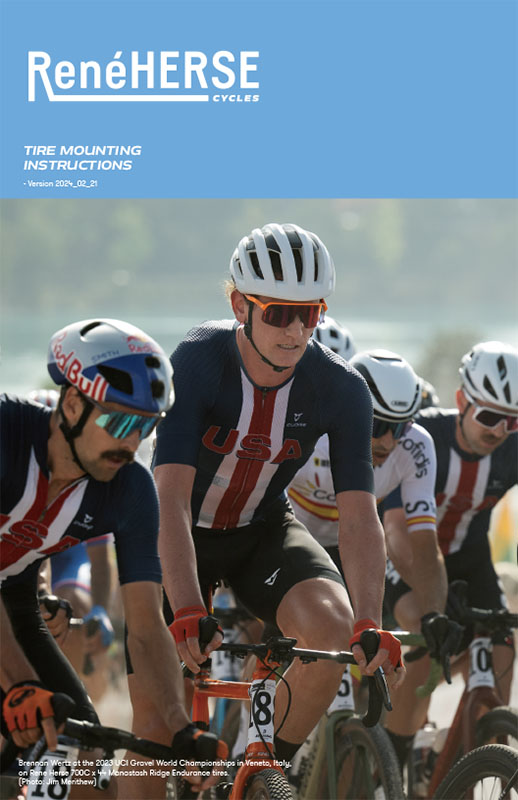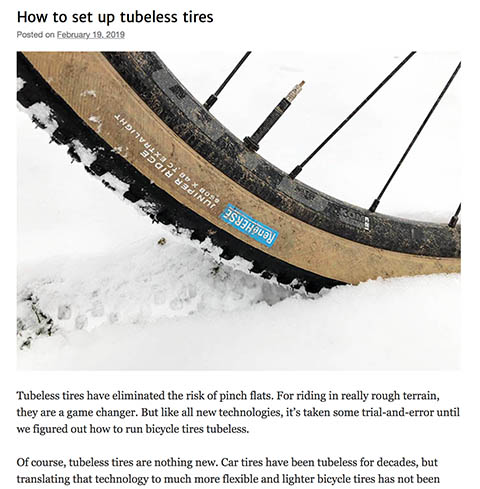Instructions
Instructions
Click on the links to see instructions.
More Information
How wide a tire will fit my bike?
- Check out our post on measuring clearances on your bike.
Optimum Pressure?
- The optimum tire pressure depends on your tire width, your weight, the terrain and your riding style. Determine the best tire pressure by experimenting what feels right. Use our Tire Pressure Calculator as a starting point.
Minimum Pressure?
- The minimum pressure of your tire depends on your weight, so we don’t list a minimum pressure for Rene Herse tires. More information about minimum pressure is available here.
Directional?
- Rene Herse tires are not directional. They work equally well mounted in either direction.
Tubeless or tubes?
- Many Rene Herse tires are tubeless-compatible. This means they can be set up tubeless (with a sealant) or used with tubes.
- Tubeless setup reduces the risk of pinch flats, which can be useful when riding at high speeds across rough terrain. Disadvantages of tubeless mounting are the more difficult setup and closer rim tolerances required to prevent blow-offs. What about performance? The sealant inside tubeless tires cancels out the gains from eliminating the tube: Tubeless tires roll as fast as tires with tubes.
- If you are leaning toward tubeless tires because you are concerned about punctures, you can use sealant inside your inner tube. (The tubes we sell have removable valve cores.) More information is in our Tubeless Tire FAQ.
How much sealant?
- With supple tires, sealant is required to seal the tire against the rim. Make sure to use enough sealant. We recommend the following amount of sealant, based on the width of your tires:
- 26 – 32 mm: 75 ml (2.5 oz.; 1/3 cup)
- 35 – 44 mm: 100 ml (3.4 oz.; 2/5 cup)
- 45 – 55 mm: 120 ml (4 oz.; 1/2 cup)
- Make sure to replenish the sealant at least once a month, as it tends to dry out.
Hard to mount
- Push the tire bead into the ‘well’ in the center of the rim all around the tire, and make sure it’s not caught on the ‘shelf’ near the edge of the tire. The tire bead does not stretch much, so it needs to be in ’well’ to give you enough slack to lift it over the rim sidewall. You can also lubricate the tire bead with soapy water to make the tire easier to seat. For step-by-step photo instructions, check out our Tire Instructions (linked at the top of this page).
Does not seat (tubeless)
- Supple tires can be harder to seat tubeless than stiff tires, since they don’t hold their shape on their own.
- Starting at the valve, pull the tire beads outward to seat them on the shelves of the rim. Work your way as far as you can. Inflate. (When air escapes only at the furthest point from the valve, the tire seats much more easily.)
- If this doesn’t work, install a tube. Seat the tire. Break one bead loose from the rim sidewall and remove the tube. (Leave the other bead seated.) Pull the bead outward (see above). Inflate.
- Also refer to our step-by-step photo instructions on how to set up tires tubeless.
How do I tell when my Rene Herse tire is worn out?
- On smooth Rene Herse all-road tires, the longitudinal lines in the center of the tread are a wear indicator. When the lines disappear, you have reached about 60-70% of the useful life of the tire: Time to think about replacing it in the near future.
- The lines also allow checking your tire pressure: If only a few lines in the center are worn, but the outer longitudinal lines still look like new, your pressure is likely too high. If the wear extends into the cross-hatched lines on the shoulders of the tire, your pressure is probably too low.
- On Rene Herse dual-purpose knobbies, once the knobs in the center are worn down to a height of 1-2 mm, it is time to replace the tire.
My tire seems narrower than it should be.
- How wide your tire ultimately ends up depends on the rim width, your casing, your inflation pressure, and whether you run the tire with tubes or tubeless. To seat your tire correctly and pre-stretch the casing, inflate the tire to the maximum pressure (of your tire or your rim, whichever is lower) and let it sit for 24 hours. The tire will stretch and ‘grow’ a bit more as you use it. Remember that the suppleness of the casing is more important for comfort and speed than a millimeter or two in width. Read more…
My tire seems heavier/lighter than it should be.
- Rene Herse tires are made by hand. This means the weight can vary from one production run to the next, and even among individual tires from the same production run. This is inevitable and not a cause for concern.
- The lightest tires are a little more supple, but can be harder to get airtight when setting them up tubeless—there is less rubber covering the sidewalls. The heavier tires are more airtight, but at the expense of a little weight. We strive to keep our tires in the middle of the tolerance range, but there will always be some variability.
- We do our best to list accurate weights for our tires. For each model, we weigh three actual samples from different production runs and take the average.
- We’ve found that these small weight differences are not noticeable on the road. (We’ve taken the lightest and heaviest of a batch and compared them back-to-back.)
Losing air (tubeless)
- Supple casings make tires fast and comfortable because they flex easily. This means that they can contact the rim in a few places, and have tiny air gaps in others – making them harder to mount and seal tubeless. It is important to work methodically and get sealant into all the tiny air gaps, on each bead (both sides of the tire). Simply pouring in sealant and going for a ride is often not enough. Click here for our step-by-step photo instructions on how to set up tires tubeless.
- If you have followed these instructions, and your tire is still losing air, there may not be enough liquid sealant inside. Sealant needs to be replenished monthly, as it tends to dry out.
Losing air (tubes)
- Sometimes, the valve core of inner tubes isn’t screwed in all the way at the factory. This can happen with all brands of tubes, including the tubes we sell. Before installing an inner tube, make sure the valve core is screwed in all the way. Use a valve core tool or a small adjustable wrench on the flat sections of the valve core, just under the locknut.
Multiple Flats
- Flat tires are no fun, especially if you have several on the same ride.
- Check to make sure you’ve removed the debris that caused the flat. If a steel wire, glass shard or rock splinter is stuck in your tire, it’ll puncture your new tube, again and again. Sometimes, the object is hard to find, if it’s embedded in the tread and only protrudes when the tire flexes under the rider’s weight.
- Other tips to reduce flats are:
- Run lower pressures. A softer tire rolls over most debris without getting punctured. (Wider tires allow running lower pressure without compromising safety.)
- Choose your route (as much as possible): shoulders of busy highways in particular are full of debris that can cause flats. Punctures are rarer on backroads (paved or gravel).
- Run a reinforced casing like our Endurance or Endurance Plus that protects against many punctures.
Leaking through sidewalls (tubeless)
- We have found that, compared to other sealants, Smart Seal greatly reduces the risk of tires leaking through their sidewalls. Many sealants often don’t have enough solids to seal the thin and supple sidewalls of Rene Herse tires. Shake the sealant vigorously for 60 seconds (a long time!) to distribute the solids before you put it into the tire. Otherwise, you’ll just inject colored water into the tire!
- If you follow these instructions, and bubbles still appear on the sidewalls, the casing may be too thin (out of tolerance). This happens very rarely, and it’s covered by our warranty. Include a photo of the bubbles when you fill our our warranty form, please.
Tubeless tire blew off
- When a tire blows off the rim, it’s usually because the rim is slightly undersize or the sidewall (G height) is not tall enough. Unfortunately, not all rims meet the current ETRTO / ISO specs. Even if the rim worked with your previous tires, supple tires require tighter rim tolerances than tires with stiff sidewalls. Read this entry in the Rene Herse Journal for more information and a list of rims with measurements.
- If the tire seats at relatively low pressure (<40 psi/2.8 bar), the rim’s bead-seat diameter is probably undersize. Also measure the G height. Refer to the tire instructions for details. Don’t mount a Rene Herse tire on rims that don’t meet ETRTO standards. When in doubt, check with the rim maker that their rim meets the ETRTO standards.
- Click here for our step-by-step photo instructions on how to set up tires tubeless.
After a many months of riding, my tires suddenly become porous (tubeless)
- Tires flex as they touch the ground with each rotation. Over time, this loosens the bond between casing threads and rubber coating. Then the sidewalls can become porous and no longer hold air if the tires are mounted tubeless. The continued flexing means that tubeless sealant cannot seal the tires any longer. This can happen before the tire tread is worn out – it depends on the tire pressure (lower puts more stress on the casing), riding style, road surfaces and other factors. The tires are still fine to ride with tubes at this stage.




